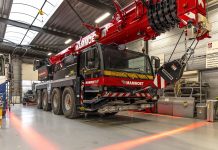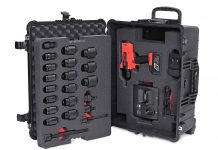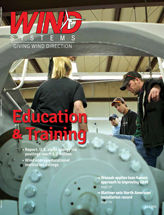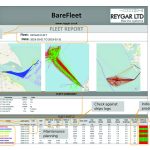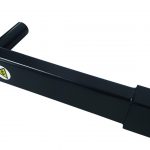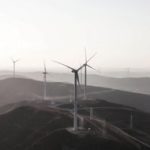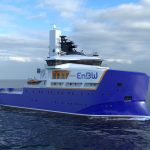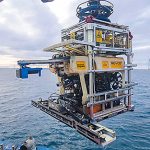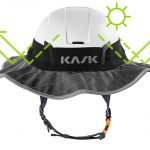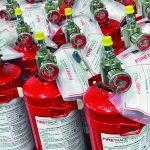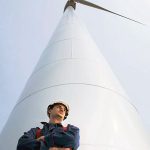The wind industry rebounded in 2014. According to the American Wind Energy Association, the 4,854MW of wind capacity added during 2014 was more than four times the amount installed in 2013. As the wind industry continues to grow, it is also undergoing a significant evolution as turbines are coming out of warranty and maintenance costs shift to owner responsibility. Wind farm operators are increasingly interested in reducing the lifecycle costs of a project — shifting some focus from productivity to maintenance. A smart approach since equipment maintenance directly effects productivity.
 Maintaining a wind plant is a complex undertaking. While the integral goal is continued turbine availability, there are many internal and external factors that can take a turbine offline. When blades aren’t turning, money is being lost. While scheduled maintenance costs are reflected in budgets and downtime is anticipated, unscheduled maintenance can greatly impact revenue through unexpected equipment replacement or repair and loss of productivity. Owners and operators are beginning to understand the implication of an efficient approach to maintenance.
Maintaining a wind plant is a complex undertaking. While the integral goal is continued turbine availability, there are many internal and external factors that can take a turbine offline. When blades aren’t turning, money is being lost. While scheduled maintenance costs are reflected in budgets and downtime is anticipated, unscheduled maintenance can greatly impact revenue through unexpected equipment replacement or repair and loss of productivity. Owners and operators are beginning to understand the implication of an efficient approach to maintenance.
With this in mind, Wanzek Construction has developed a lean Kaizen process that addresses both scheduled and unscheduled maintenance issues. Kaizen, meaning “change for the better,” refers to the practice of continuous improvement. It is a long-term approach that targets small, incremental changes in processes in order to improve efficiency and quality. Karen Naland, director of quality and development at Wanzek, began implementing a company-wide lean Kaizen approach in 2014 that has since been implemented by the company’s Renewable Energy Services group through wind system maintenance. According to Eddy Grunenwald, who handles business development for Wanzek’s O&M Services team, “Every operating wind site is under pressure to reduce cost and improve returns. At the same time, wind turbines are larger, more complex their numbers are expanding quickly.” Grunenwald believes that upping the resources for operations and maintenance requirements is not a sustainable solution. “The future belongs to owners and service providers who make continuous improvement a key factor in their service offerings,” he said.
Grunenwald has put this to practice, earning a yellow belt in continuous improvement through Wanzek’s Operational Excellence initiative. During a client visit, he was made aware of an excess in man-hours per turbine required for maintenance. Wanzek responded immediately with a proposal to conduct a lean event to identify waste in the maintenance process and implement change that would reduce the number of man-hours required. The event also served as a forum for the exchange of ideas and best practices across multiple, client-operated sites.
 Preparation for the lean event included a review of the processes and procedures that were in place. Wanzek found that procedures overlapped and that task performance required technicians to move throughout the turbine without regard for the amount of time spent on a task. This led to a focus on the reorganization of crews and responsibilities. Special attention was paid to maintaining safety regulations; allowing the time needed to perform a job safely, while reducing time wasted. One example involved moving a crew from the nacelle into the turbine hub.
Preparation for the lean event included a review of the processes and procedures that were in place. Wanzek found that procedures overlapped and that task performance required technicians to move throughout the turbine without regard for the amount of time spent on a task. This led to a focus on the reorganization of crews and responsibilities. Special attention was paid to maintaining safety regulations; allowing the time needed to perform a job safely, while reducing time wasted. One example involved moving a crew from the nacelle into the turbine hub.
“Our crews have completed safety at heights and rescue training and this is not a task that can be hurried,” Grunenwald said. “However, the old process had the crews moving into and out of the hub several times. We changed the process so that while a crew is in the hub, they perform as many tasks as is safe and practical.”
With Wanzek’s direction, the client developed a maintenance program made up of four crews, performing tasks directly related to the area in which they work. Wanzek followed-up with modifications to ensure standardization of the improvements. The result was a reduction of over 50 percent in man-hours per turbine.
“I knew we would obtain results,” Grunenwald said. “These results really impressed me.”
Given the positive results, Wanzek will continue its lean Kaizen approach, determining areas that waste can be eliminated. Defining a direct approach to efficiency and improvement requires the company to align its quality and development group with its safety program. Arnold Jelinek, vice president of Wanzek, maintains the need for safety efforts to inform quality initiatives.
 “Our interest in Kaizen is due to its focus on small changes to create big impact. This allows us to address our clients’ need for a quick turn-around while promoting our strict safety policy,” he said.
“Our interest in Kaizen is due to its focus on small changes to create big impact. This allows us to address our clients’ need for a quick turn-around while promoting our strict safety policy,” he said.
Wanzek has made a commitment to invest in continuous improvement as a way to deliver streamlined services that benefit the client’s bottom line. Within the last year, 110 Wanzek corporate and field personnel have participated in Six Sigma yellow belt training, led by the company’s Six Sigma Master Black Belt quality and development director. This has resulted in refined and value-added processes and procedures.
The Kaizen approach requires employees to contemplate procedures and processes and determine the outcome. The same is true for Wanzek’s safety program. The company has an established observation program, R4, which provides the opportunity for employees to be engaged in the company’s safety processes through active participation in safety systems and through an employee observation and feedback process.
Jelinek believes this results in sharper employees and better business practices. “Both our quality initiatives and our safety program encourage our employees to stop and think,” he said.
Applied to wind maintenance service, Wanzek’s approach resulted in renewed turbine performance, reduced time resources, substantial procedural improvements and improved daily output. Fueled by his success, Grunenwald is turning his attention to project start-up. Since much of the project pace is determined in the planning stage, Grunenwald sees an opportunity to apply lean initiatives at the onset.
Jelinek is excited that this innovation is coming from within the company.
“The results achieved by our wind O&M team have been outstanding. Jelinek said. We want each of our employees to be trained in the Kaizen method and to apply it, guided by our director of quality and development, in instances that could result in safe project efficiencies.”
Given AWEA’s release in April that the U.S. now has installed over 48,000 turbines, there should be plenty of opportunity.
For more information, visit them online at www.wanzek.com.
















